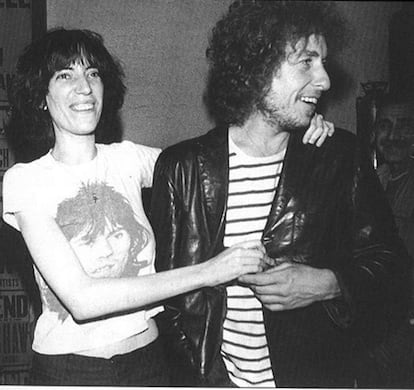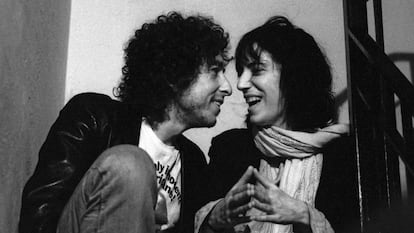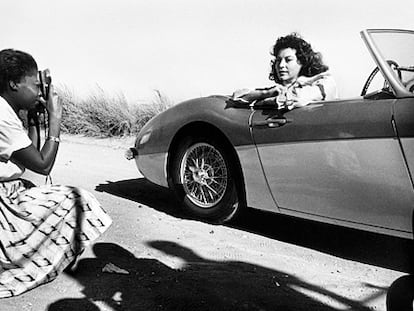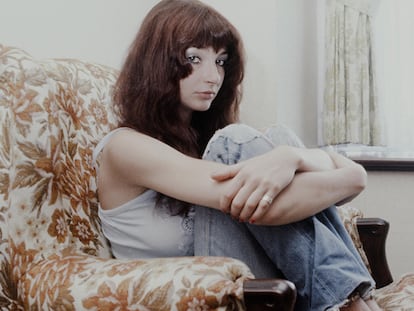The keys to Patti Smith and Bob Dylan’s famous friendship: Art, admiration, respect and a great love of music
The pair maintain a powerful bond that speaks to a way of understanding both songs and life from a bygone era
Patti Smith and Bob Dylan have known each other since 1975 and it could be said that their friendship has transcended ordinary life and entered the realms of greatness. Greatness in its original sense and not as a cliché is always complex and, as we know, the complex is often reduced, ridiculed and even vilified in a world driven by capital, post-truth and social media noise. The complex is always the enemy of ignorance.
Patti Smith has just given some amazing concerts in Spain, reminding us that her significance to rock’n’roll is also greater than what we are used to seeing on stage. They were concerts in which she performed songs written by Dylan, such as the simple yet moving One Too Many Mornings, composed just after his arrival in New York in the early 1960s. That Bob Dylan, who left everything in Minnesota to go to meet a sick Woody Guthrie and start his career as a musician in Greenwich Village, was the example that a very young Patti Smith was following when she too dropped everything – in her case in New Jersey – for a life in Greenwich Village.
Both Bob and Patti lived for music and have dedicated their lives to it. They have wholeheartedly pursued what they believe in, moving away from the territory inhabited by their family and childhood friends – in short, from society in general. They pursued their dream and ended up in the territory of art. And they were great ambassadors for that art and that space that is dwindling in this current era: an era in which culture and art are becoming increasingly irrelevant and damaged by all kinds of interests, social mechanics and poor thinking.
Patti and Bob still inhabit our world, although they seem to be from another. As Dylan acknowledged in his last interview, published in The New York Times to promote his 2020 album Rough and Rowdy Ways, he is aware that his world is “obsolete.” Not only are he and Patti’s worlds obsolete, what they represent is hardly of interest anymore, namely a commitment to the actual art of music – to a craft that, in its essence, has more to do with the value of the song itself than with the giant screens and festival pyrotechnics. Their friendship, therefore, also represents something more transcendental than most of us can grasp.
They met in 1975 when Dylan went backstage to see Patti after a concert at The Bitter End club in New York. She was a 29-year-old poet involved in rock’n’roll and causing a stir at the start of the punk era; he was a 34-year-old counter-culture icon. As Patti has recalled on more than one occasion, it was an unfortunate encounter. An elusive figure who was hard to run into at any given event, Bob walked into Patti’s dressing room and asked, “Are there any poets around here?” To which she replied, “I hate poetry!” Many decades later, Patti herself acknowledged that she behaved like a high school teen who pretends to be uninterested when a boy she likes approaches.
Patti has also said that Dylan in the flesh can never be separated from Dylan the legend, an observation shared by other musicians. From a place of self-consciousness and arrogance, the person and legend merge into a being whose gestures and silences possess a strange and definitive power. Patti fell under the spell. That particular night, Bob left quickly but saw the funny side. Days later, the two were photographed laughing at a private party at which she even teased him to move out of the way for the photographer. The camera captured a moment of spontaneity and authenticity.

Whatever happened between them then, it led to mutual admiration. It is difficult to be friends with Bob Dylan who is an evasive character, even with those closest to him, but Patti Smith managed. During those early years of their friendship, Patti has said that she used to meet Dylan for walks around New York during which they would discuss all kinds of things. And one thing you learn early on in life, unless you’re an orangutan, is that going for a walk and a chat creates a closer emotional bond than sex. Patti and Bob bonded a lot.
In 1994, Patti lost her husband, Fred Sonic Smith, a former member of the band MC5. Not long after, her brother died, catapulting Patti into a depression. It should be remembered that Patti had abandoned songwriting and much of her artistic life in the 1980s and 1990s to devote herself to her family life with Fred and their two children. But even before Fred and her brother’s deaths, she had been badly affected by the death of her other great love, Robert Mapplethorpe, in 1989. Mapplethorpe had been her lover, companion, friend and confidant in those early years in New York, as she herself tells it in Just Kids, a book that took her 10 years to write.
In the middle of her depression, Patti got a call from Bob. He wanted her to perform at a series of concerts in the US. I like to recall this story with my friend Rafa Cervera, a great music critic and an admirer of Patti Smith, who has written himself about this extraordinary relationship between the two rock’n’roll legends. As Patti noted, Bob was the only one who could convince her to get back on stage. In 1995, she accompanied Bob for seven nights and, each of those nights, she would sing one of his songs, Dark Eyes, with these lines: “I live in another world where life and death are memorized… But I feel nothing for their game where beauty goes unrecognized.” Patti not only returned to the stage, she came back to life.
She began to compose and, above all, write books of poetry, memoirs and essays. In short, she made a big comeback. And Bob went on with his never-ending tour, his obsolete records and his mysterious persona.
In 2016, Bob Dylan turned the literary world on its head when he won the Nobel Prize for Literature. Writers of all descriptions were up in arms, offended by the fact that the most coveted award for literature was going to a songwriter and performer. It was a strange and amusing time, especially when it became clear that the Nobel Committee, that entity of mothballs that ended up mired in sex scandals, did not know the essence of the laureate: Bob Dylan was not a writer aspiring to win prizes. But how could the Swedish Academy know that when what they were looking for was publicity?
It seems that Dylan came into the world to change it with his lyrics – and perhaps he has achieved more than the vast majority of writers of books. In 2016, when he became the Nobel Laureate, little in his behavior changed. He did nothing of what might have been expected of him. He simply went about his business, even in matters close to his heart, and so it was that he asked Patti Smith to be the one to sing for him at the prize-giving ceremony. A faux pas? Not for her. That gesture honored the code that Patti and Bob shared.
Patti sang A Hard Rain’s A-Gonna Fall, one of the first compositions she learned as a teenager from Dylan, and she was overcome by emotion. She stumbled over the words and had to stop the song and start over. The cynics believed it was staged but many others simply saw an older, nervous woman. Many others didn’t understand anything at all while maybe a handful of nuts saw the ultimate beauty of a unique friendship, and the ultimate beauty of the art of music – the art of a shared oral tradition.
In an article in The New Yorker, Patti Smith recalled what happened: “I was obliged to stop and ask pardon and then attempt again while in this state and sang with all my being, yet still stumbling. It was not lost on me that the narrative of the song begins with the words ‘I stumbled alongside of twelve misty mountains,’ and ends with the line ‘And I’ll know my song well before I start singing.’ As I took my seat, I felt the humiliating sting of failure, but also the strange realization that I had somehow entered and truly lived the world of the lyrics.”
If Dylan’s literature, and therefore his music – and even the man’s iconic status – meant anything, it was perfectly represented in Patti Smith. Those nerves and that heart-wrenching song had more impact than the best of speeches. I imagine that’s hard to understand for writers who regard language academies as a more sacred than what, for example, can be found in a village choir clapping their hands and singing traditional songs.
Patti and Bob’s friendship continues to this day, but our modern world has nothing to do with them and what they represent. The world we inhabit is hostile and moves too fast. It is a world where there is a tragic lack of poetry while advertising campaigns pass for beauty. It’s the same world Patti Smith and Bob Dylan faced with their songs – two soulmates at the service of art, which is something bigger than the reality we are currently being persuaded to live.
Tu suscripción se está usando en otro dispositivo
¿Quieres añadir otro usuario a tu suscripción?
Si continúas leyendo en este dispositivo, no se podrá leer en el otro.
FlechaTu suscripción se está usando en otro dispositivo y solo puedes acceder a EL PAÍS desde un dispositivo a la vez.
Si quieres compartir tu cuenta, cambia tu suscripción a la modalidad Premium, así podrás añadir otro usuario. Cada uno accederá con su propia cuenta de email, lo que os permitirá personalizar vuestra experiencia en EL PAÍS.
¿Tienes una suscripción de empresa? Accede aquí para contratar más cuentas.
En el caso de no saber quién está usando tu cuenta, te recomendamos cambiar tu contraseña aquí.
Si decides continuar compartiendo tu cuenta, este mensaje se mostrará en tu dispositivo y en el de la otra persona que está usando tu cuenta de forma indefinida, afectando a tu experiencia de lectura. Puedes consultar aquí los términos y condiciones de la suscripción digital.
More information
Últimas noticias
NASA discovers Titan doesn’t have an ocean, but a ‘slushy ice layer’ that increases possibility of life
Innocence lost in the forest of the child soldiers: ‘Each leader of the armed group had his girls’
‘Fallout’ or how the world’s largest company turned an anti-capitalist apocalyptic Western into a phenomenon
From inflation to defending migrants: Eileen Higgins and Zohran Mamdani inaugurate the new Democratic resistance against Trump
Most viewed
- ‘El Limones’ and the growing union disguise of Mexican organized crime
- Christian Louboutin: ‘Young people don’t want to be like their parents. And if their parents wear sneakers, they’re going to look for something else’
- The low-cost creative revolution: How technology is making art accessible to everyone
- ‘We are dying’: Cuba sinks into a health crisis amid medicine shortages and misdiagnosis
- Liset Menéndez de la Prida, neuroscientist: ‘It’s not normal to constantly seek pleasure; it’s important to be bored, to be calm’












































